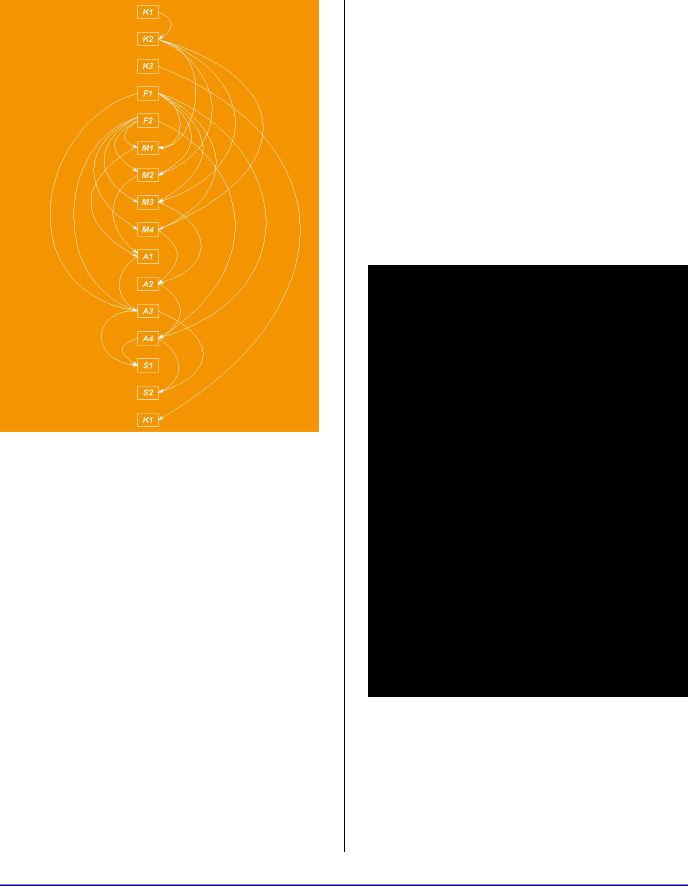
- •Introduction
- •Standard Radix-2 FFT Algorithm
- •Figure 1. Standard Structure of the 16-Point FFT
- •Listing 1. fft32_unoptimized.asm
- •Table 1. Core Clock Cycles for N-point Complex FFT
- •Figure 2. Reorganized Structure of the 16-Point FFT
- •Pipelining of the Algorithm
- •Figure 3. Reorganized Structure’s Dependencies
- •Table 6. Pipelined Butterflies
- •The Code
- •Listing 2. fft32.asm - fragment
- •Usage Rules
- •Appendix
- •Complete Source Code of the Optimized FFT
- •Listing 3. fft32.asm
- •References
- •Document History

new KALU operations (K1, K2 and K3) have been added to Table 3. Time to write the code? Well, no – let us figure out how to pipeline it first.
Mnemonic |
Operation |
|
|
K1 |
Virtual Pointer Offset Mask |
|
|
K2 |
Twiddles Fetch |
|
|
K3 |
Virtual Pointer Offset Increment |
|
|
F1 |
Fetch Input1,2 of the Butterfly1 |
|
|
F2 |
Fetch Input1,2 of the Butterfly2 |
|
|
M1 |
Real(Input2) * Real(twiddle) |
|
|
M2 |
Imag(Input2) * Imag(twiddle) |
|
|
M3 |
Real(Input2) * Imag(twiddle) |
|
|
M4 |
Imag(Input2) * Real(twiddle) |
|
|
A1 |
M1–M2 = Real(Input2*twiddle) |
|
|
A2 |
M3+M4 = Imag(Input2*twiddle) |
|
|
A3 |
Real(Input1) +/- A1 = Real(Output1,2) |
|
|
A4 |
Imag(Input1) +/- A2 = Imag(Output1) |
|
|
S1 |
Store(Output1, both Butterflies) |
|
|
S2 |
Store(Output2, both Butterflies) |
|
|
Table 4. Single Butterfly Done Linearly – Modified
ADSP-TS20x Implementation
Pipelining of the Algorithm
Figure 3 shows the algorithm’s operations from Table 4 with arrows showing the dependencies. The arrows of the dependencies indicate that the result of the operation at the start of the arrow is used by the operation at the end of that arrow and, thus, must be completed first to ensure correct data. Some arrows have a stall associated with them, specifically:
a
K2 -> M1, M2, M3, M4
F1, F2 -> M1, M2, M3, M4, A3, A4 M1, M2 -> A1
M3, M4 -> A2 A1, A2 -> A3, A4
This means that if the operation at the start of the arrow is immediately followed by the operation at the end of that arrow, the result will be correct, but code execution will produce a stall. Thus, to fully optimize the code, operations at the ends of arrows with stalls must be kept more than one instruction line apart.
Figure 3. Reorganized Structure’s Dependencies
A quick observation of the dependencies in Figure 3 is sufficient to analyze the level of pipelining and the number of compute block registers needed to do it.
Writing Efficient Floating-Point FFTs for ADSP-TS201 TigerSHARC® Processors (EE-218) |
Page 7 of 16 |

|
|
|
|
Dependency |
|
|
Max |
|
|
Compute Block |
|
|
State |
|
|
|
|
Dep |
|
|
Registers |
|
|
|
|
|
To States |
|
|
|
|
|
|||
|
|
|
|
|
|
Cycles |
|
|
Needed |
|
|
|
|
|
|
|
|
|
|
|
|
||
|
|
|
|
|
|
|
|
|
|
|
|
|
K1 |
|
|
K2 |
|
|
1 |
|
|
0 |
|
|
|
|
|
|
|
|
|
|
|
|
|
|
K2 |
|
M1,M2,M3,M4 |
5 |
|
4*([5/4]+1)=8 |
|
||||
|
|
|
|
|
|
|
|
||||
|
K3 |
|
|
K1 |
|
|
1 |
|
|
0 |
|
|
|
|
|
|
|
|
|
|
|
|
|
|
F1 |
|
|
M1,M2,M3,M4, |
|
10 |
|
|
4*([10/4]+1)=16 |
|
|
|
|
|
A1,A2 |
|
|
|
|
||||
|
|
|
|
|
|
|
|
|
|
||
|
|
|
|
|
|
|
|
|
|
|
|
|
F2 |
|
|
M1,M2,M3,M4, |
|
10 |
|
|
4*([10/4]+1)=16 |
|
|
|
|
|
A1,A2 |
|
|
|
|
||||
|
|
|
|
|
|
|
|
|
|
||
|
|
|
|
|
|
|
|
|
|
|
|
|
M1 |
|
|
A1 |
|
|
2 |
|
|
2([2/4]+1)=2 |
|
|
|
|
|
|
|
|
|
|
|
|
|
|
M2 |
|
|
A1 |
|
|
2 |
|
|
2([2/4]+1)=2 |
|
|
|
|
|
|
|
|
|
|
|
|
|
|
M3 |
|
A2 |
2 |
|
2([2/4]+1)=2 |
|
||||
|
|
|
|
|
|
|
|
||||
|
M4 |
|
A2 |
2 |
|
2([2/4]+1)=2 |
|
||||
|
|
|
|
|
|
|
|
||||
|
A1 |
|
|
A3,A4 |
|
|
2 |
|
|
2([2/4]+1)=2 |
|
|
|
|
|
|
|
|
|
|
|
|
|
|
A2 |
|
|
A3,A4 |
|
|
2 |
|
|
2([2/4]+1)=2 |
|
|
|
|
|
|
|
|
|
|
|
|
|
|
A3 |
|
S1,S2 |
1 |
|
4([1/4]+1)=4 |
|
||||
|
|
|
|
|
|
|
|
||||
|
A4 |
|
|
S1,S2 |
|
|
1 |
|
|
4([1/4]+1)=4 |
|
|
|
|
|
|
|
|
|
|
|
|
|
|
S1 |
|
|
none |
|
|
0 |
|
|
0 |
|
|
|
|
|
|
|
|
|
|
|
|
|
|
S2 |
|
|
none |
|
|
0 |
|
|
0 |
|
|
|
|
|
|
|
|
|
|
|
|
|
|
|
|
|
Total Regs |
|
|
|
|
|
60 |
|
|
|
|
|
|
|
|
|
|
|
|
|
Table 5. Number of Compute Block Registers Required to Pipeline the Butterflies
Full pipelining, as mentioned earlier, would give a 4-cycle SIMD pair of butterflies. Thus,
Pipelined_CB_Registers_Per_State_Output = Unpipelined_CB_Registers_Per_State_Output * ([Maximum_Dependency_Cycles/4]+1)
Here, [x] denotes the integer part of the number x. We can therefore determine the number of compute block registers needed, as shown in Table 5. Note that A3 and A4 require twice as
a
many output registers as M1, M2, M3, M4, A1 and A2 since A3 and A4 are add/subtracts.
The resulting requirement to fully pipeline this code is 60 compute block registers, out of 64 total – just barely made it!
|
Cycle/ |
|
|
JALU |
|
|
KALU |
|
|
MAC |
|
|
ALU |
|
|
Operation |
|
|
|
|
|
|
|
|
|
||||
|
|
|
|
|
|
|
|
|
|
|
|
|
|
|
|
|
|
|
|
|
|
|
|
|
|
|
|
|
|
1 |
|
|
F1 |
|
K1 |
|
M4-- |
|
A3--- |
|||||
|
|
|
|
|
|
|
|
|
|
|||||
2 |
|
|
F2 |
|
K2 |
|
M2- |
|
A4--- |
|||||
|
|
|
|
|
|
|
|
|
|
|
||||
3 |
|
|
S1--- |
|
|
|
|
M3- |
|
A2-- |
||||
|
|
|
|
|
|
|
|
|
|
|||||
4 |
|
|
S2--- |
|
K3 |
|
M1 |
|
A1- |
|||||
|
|
|
|
|
|
|
|
|
|
|||||
5 |
|
|
F1+ |
|
K1+ |
|
M4- |
|
A3-- |
|||||
|
|
|
|
|
|
|
|
|
|
|||||
6 |
|
|
F2+ |
|
K2+ |
|
M2 |
|
A4-- |
|||||
|
|
|
|
|
|
|
|
|
|
|
||||
7 |
|
|
S1-- |
|
|
|
|
M3 |
|
A2- |
||||
|
|
|
|
|
|
|
|
|
|
|||||
8 |
|
|
S2-- |
|
K3+ |
|
M1+ |
|
A1 |
|||||
|
|
|
|
|
|
|
|
|
|
|||||
9 |
|
|
F1++ |
|
K1++ |
|
M4 |
|
A3- |
|||||
|
|
|
|
|
|
|
|
|
|
|||||
10 |
|
|
F2++ |
|
K2++ |
|
M2+ |
|
A4- |
|||||
|
|
|
|
|
|
|
|
|
|
|
||||
|
11 |
|
|
S1- |
|
|
|
|
|
M3+ |
|
|
A2 |
|
|
|
|
|
|
|
|
|
|
|
|
|
|
|
|
|
12 |
|
|
S2- |
|
|
K3++ |
|
|
M1++ |
|
|
A1+ |
|
|
|
|
|
|
|
|
|
|
|
|
|
|
|
|
13 |
|
|
F1+++ |
|
K1+++ |
|
M4+ |
|
A3 |
|||||
|
|
|
|
|
|
|
|
|
|
|||||
|
14 |
|
|
F2+++ |
|
|
K2+++ |
|
|
M2++ |
|
|
A4 |
|
|
|
|
|
|
|
|
|
|
|
|
|
|
|
|
15 |
|
|
S1 |
|
|
|
|
M3++ |
|
A2+ |
||||
|
|
|
|
|
|
|
|
|
|
|||||
16 |
|
|
S2 |
|
K3+++ |
|
M1+++ |
|
A1++ |
|||||
|
|
|
|
|
|
|
|
|
|
|
|
|
|
|
Table 6. Pipelined Butterflies
We pipeline this fully symbolically, using the mnemonics of Table 4 and Figure 3. The pipelining is shown in Table 6, in which “+” in the operation indicates the operation that corresponds to the next set of the butterflies and “-” corresponds to the operation in the previous set of the butterflies.
Writing Efficient Floating-Point FFTs for ADSP-TS201 TigerSHARC® Processors (EE-218) |
Page 8 of 16 |
